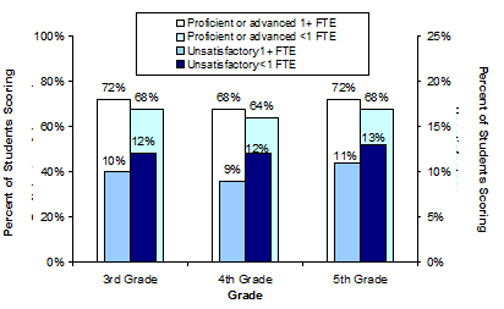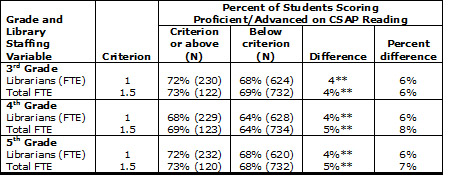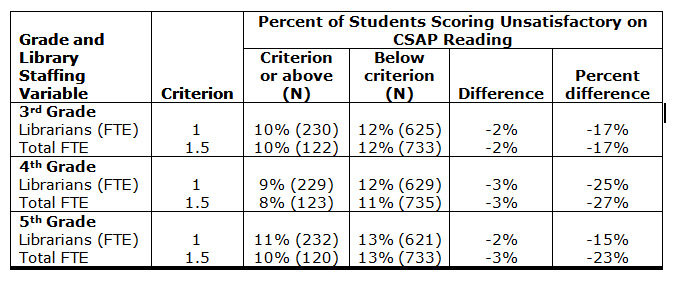Known links between higher school library staffing levels and better CSAP scores are confirmed by a recent examination of 2007-08 data on school libraries and 2008 data on students scoring proficient or advanced on CSAP reading. In addition, better-staffed school libraries are also associated with reduced percentages of students receiving unsatisfactory CSAP scores, thereby helping to close the achievement gap.
Endorsed Librarian Staffing
For purposes of this study, the term “librarian” refers to an individual endorsed by the state of Colorado as a School Librarian, a Teacher Librarian, or a Media Specialist. Total FTE includes support staff.
Elementary schools with at least 1 full-time endorsed librarian averaged better CSAP performance than those with less than 1 full-time endorsed librarian. More students earned proficient or advanced reading scores and fewer students earned unsatisfactory scores where there was a full-time endorsed librarian (see Chart 1). Elementary schools with librarians averaged 68 to 72 percent of students scoring proficient or advanced and 9 to 11 percent scoring unsatisfactory. Schools without librarians averaged 64 to 68 percent scoring proficient or advanced and 12 to 13 percent unsatisfactory (see Chart 1).
Chart 1
CSAP Reading Performance by Librarian Staffing
Grades 3 to 5, 2008
Total School Library Staffing
In addition to full-time endorsed librarians, total library staff in full-time equivalents (FTE) makes a difference in CSAP reading scores.
For elementary schools with at least 1 full-time endorsed librarian or 1 and a half FTE library staff, the percentage of third, fourth, and fifth grade students scoring proficient or advanced in reading was consistently higher than for schools with lower staffing levels—a 4 to 5 percent absolute difference and a 6 to 8 percent proportional difference (see Table 1).[note]In the comparison-of-means tables, two differences are reported: the absolute difference (simply labeled “difference”) and the proportional difference (labeled “percent difference”). To understand the distinction, consider a case where the two percentages of students earning proficient or advanced CSAP scores are 20 percent and 30 percent. The absolute difference between the two is 10 percent; but, the proportional difference is 50 percent (30 minus 20 equals 10, and 10 is half of 20).[/note]
Table 1
Percent of Students Scoring Proficient or Advanced in Reading on the Colorado Student Assessment Program (CSAP) by Library Staffing Level
Grades 3-5, 2008
**p ≤ .01
Schools with more librarian staffing also tended to have a lower percentage of students scoring unsatisfactory in reading—a 2 to 3 percent absolute difference and a 15 to 25 percent proportional difference (see Table 2). An even stronger pattern in scores was seen in schools having at least 1 and a half FTEs (ideally, at least 1 librarian and support staff)—a 2 to 3 percent absolute difference and a 17 to 27 percent proportional difference.
Table 2
Percent of Students Scoring Unsatisfactory in Reading on the Colorado Student Assessment Program (CSAP) by Library Staffing Level,
Elementary schools with better-staffed libraries have a significantly higher percentage of students scoring proficient or advanced in reading and a significantly lower percentage of students scoring unsatisfactory. Based on the proportional differences reported above, the evidence indicates that library staff can have a positive impact on all students. In addition, the fact that proportional differences associated with unsatisfactory scores are so dramatic suggests that a well-staffed library can be especially important for the neediest students. These results indicate that school library staffing can play an important role in narrowing the achievement gap.
These findings come from the third Colorado study of the impact of school libraries and librarians on academic achievement, and the second one to examine their impact on student performance on the Colorado Student Assessment Program (CSAP) tests. The findings about library staffing levels in this latest study are consistent with those of the two previous studies. Students tend to perform better on achievement tests where school libraries have more full-time equivalents (FTEs) of staffing, especially at the librarian level. Between 2000 and 2009, similar findings have been generated by studies in 17 other states (Alaska, California, Florida, Illinois, Indiana, Iowa, Massachusetts, Michigan, Minnesota, Missouri, New Mexico, New York, North Carolina, Oregon, Pennsylvania, Texas, and Wisconsin) as well as the Canadian province of Ontario. Many of these studies also present evidence that the relationships between library staffing and test performance cannot be explained away by other school or community conditions. More recent studies in Indiana and Idaho suggest some of the day-to-day dynamics of school life that may account for these relationships. In Idaho (the latest of these studies), higher test scores tended to be earned by students whose principals felt that their schools did an excellent job of teaching information, communication, and technology (ICT) literacy. In turn, such self-assessments were more likely at schools where principals valued as essential (or at least desirable) several policies and practices associated with fully credentialed librarians:
- Flexibly scheduled access to the library,
- Collaboration between the school librarian and classroom teachers in the design and delivery of instruction,
- Provision of in-service professional development opportunities to teachers by the librarian,
- Appointment of the librarian to key school committees,
- Regular meetings between librarian and principal, and
- Addressing the instructional role of the librarian during teacher hiring interviews.
Credentialed librarians were 2 to 3 times more likely to report engaging in most of these activities at least weekly than others deputized to run the library.


